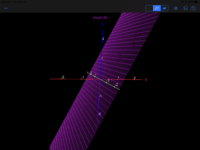Line integrals are known for finding the area under a function along a path or curve.
If I have a function [MATH]f(x,y) = 2x[/MATH] and I have a line segment C from [MATH](1,2)[/math] to [math](3,5)[/MATH], the evaluation of the line integral is
[MATH]\int_C f(x,y) \ ds = \frac{\sqrt{13}}{2} \int_{1}^{3} 2x \ dx = 4\sqrt{13}[/MATH]
The function [MATH]f(x,y) = 2x[/MATH] is in the xz-plane while the line segment C is in the xy-plane. The path will never be under the function! How can this integral be visualized? Or What area I am calculating here?
If I have a function [MATH]f(x,y) = 2x[/MATH] and I have a line segment C from [MATH](1,2)[/math] to [math](3,5)[/MATH], the evaluation of the line integral is
[MATH]\int_C f(x,y) \ ds = \frac{\sqrt{13}}{2} \int_{1}^{3} 2x \ dx = 4\sqrt{13}[/MATH]
The function [MATH]f(x,y) = 2x[/MATH] is in the xz-plane while the line segment C is in the xy-plane. The path will never be under the function! How can this integral be visualized? Or What area I am calculating here?

